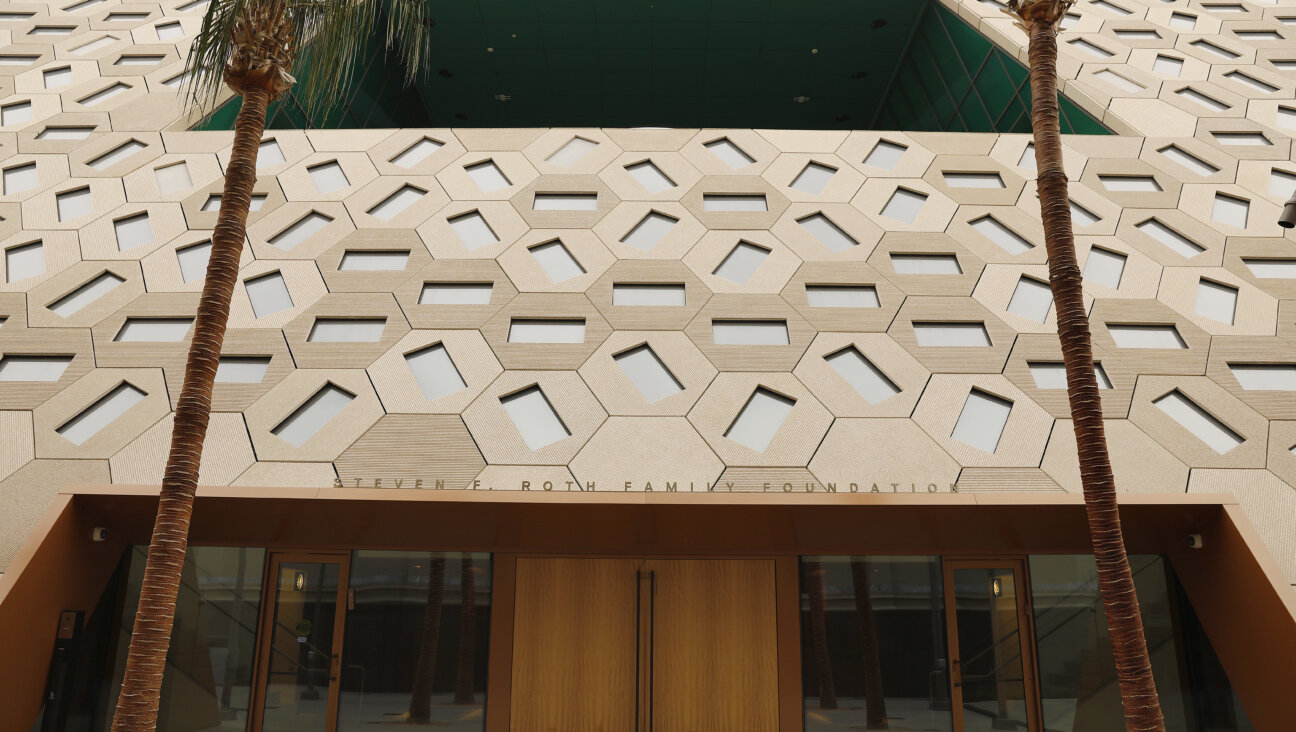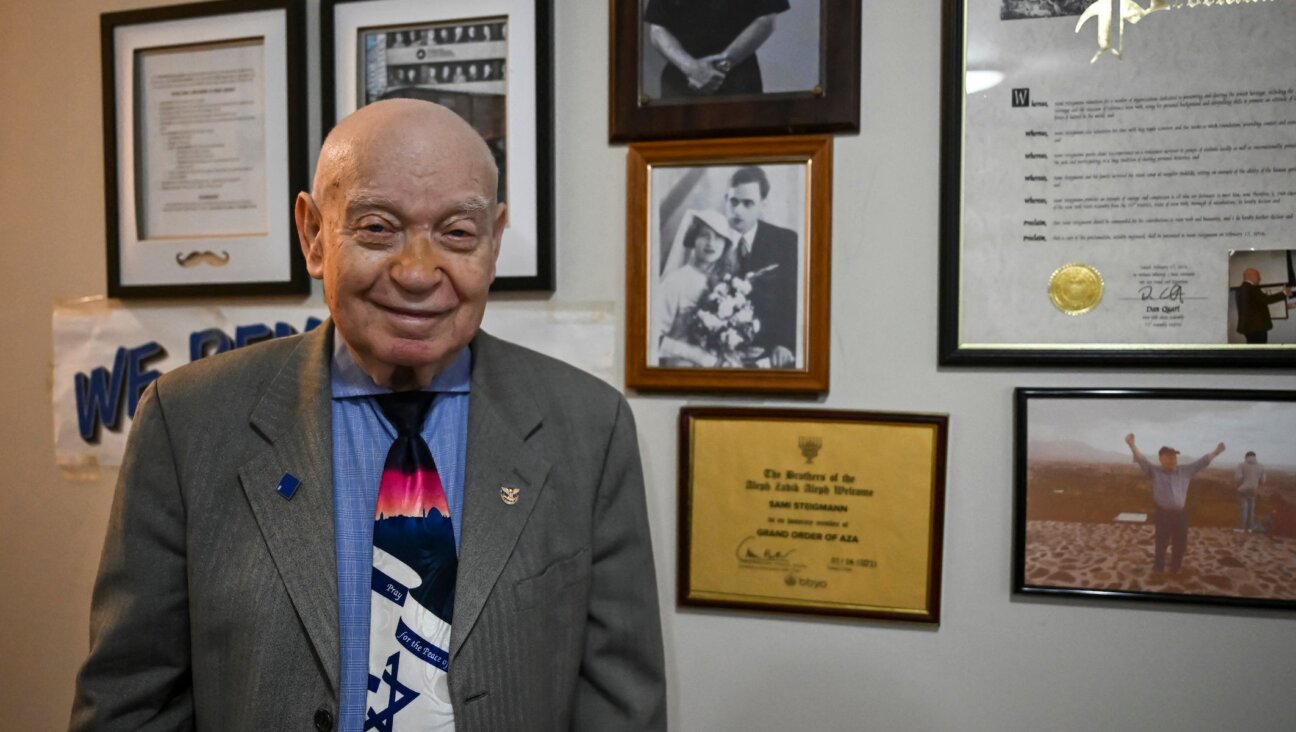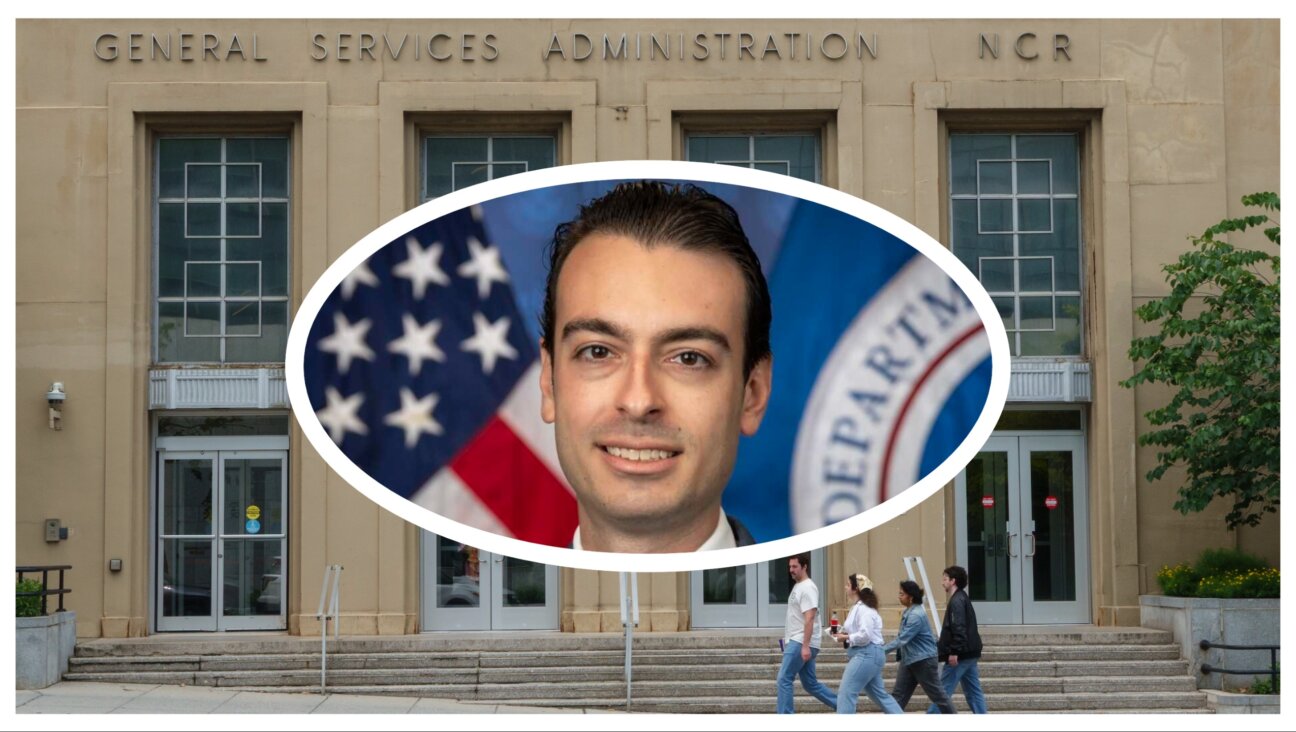She revived this Cincinnati synagogue — but that’s not nearly enough for her

Miriam Terlinchamp Image by Courtesy of Miriam Terlinchamp
The board of Temple Sholom in a suburb of Cincinnati, Ohio, was still reeling from the beginning of lockdown. Then, Rabbi Miriam Terlinchamp presented her big idea over Zoom:
Take the synagogue’s entire $18,000 budget for the Jewish High Holidays and spend it on pre-recorded Rosh Hashanah and Yom Kippur services — and get the services on local TV.
This was April, when most synagogues were still scrambling to organize weekly live-streamed services while predicting massive budget shortfalls amid an economic freefall. Only a few had begun planning the High Holidays in earnest, and for many a top priority was to save money.
Temple Sholom’s board decided to trust Terlinchamp, their rabbi of 10 years. She had already guided what was once a shrinking congregation to sell their crumbling, 70-year-old building and move to a rented space farther into the suburbs; eliminate membership dues; and embark on an expensive marketing campaign built around sketch comedy videos.
Synagogue members feel that Terlinchamp’s ideas have paid off: When she arrived, there were 250 families, of mostly elderly members; now there are 310, and, the synagogue says, they are on better financial footing than ever.
“She’s been willing to take huge leaps with us,” said Stephanie Rhein, current board president. “So far, we’ve landed on our feet every time.”
The board authorized Terlinchamp’s High Holidays plan. Hundreds of hours of shooting and editing later, her main offering to the world — the “Evening of Awe,” an hourlong set of original songs on themes of unity and social justice, interspersed with short sermons, filmed in a studio with the grungy aesthetic style of “MTV Unplugged” — is set to air on a local Cincinnati MeTV channel on Sunday Sept. 20 at 6 p.m. Sholom also created four other traditional-style services for the members to watch online, featuring prayer book readings by congregants.
These are not the only High Holiday services on TV this year: Three large synagogues are airing theirs live on the Jewish Broadcasting Service, a cable channel. Other synagogues have created pre-recorded services as well. But Temple Sholom is the only small congregation that will be on TV, and the only one that has created an entirely different kind of worship service from the traditional, rarefied liturgy of the season.
To someone used to traditional High Holiday services, or even untraditional ones, the “Evening of Awe” feels like an earnest, prime-time infomercial for Judaism. The songs, written by the musician and producer Ric Hordinski, a secular Buddhist, are genuine and well-conceived, with some lyrics drawn from the prayerbook. Though the standout songs, like “Are You Gonna Bow Down,” a protest song, make no direct reference to Judaism.

Hordinski, left, and Terlinchamp, center, at the monastery studio where they filmed the High Holiday services. Image by Courtesy of Miriam Terlinchamp
Terlinchamp, with bright eyes, wide smile and blonde hair falling over her shoulders, does an end-run around the usual solemn, penitent rabbinic look of the season. Like Hordinski’s songs, her sermons, on compassion, forgiveness and unity, seem to aim to catch the interest of the widest number of viewers, and maybe some Jews as well.
Which is the point, Terlinchamp says. Her goal is to spread Jewish values to whoever may be seeking them, including spiritual “seekers” from other religions as well as Jews who have felt “wounded” by their faith.
And if this new kind of holiday special brings more people to Temple Sholom — they’re rearranging the website to cater to visitors brought by the special — it might whet Terlinchamp’s appetite to make more, and draw her away from the synagogue.
She isn’t satisfied by rabbinic work, she says, and her evangelist approach to Judaism isn’t appreciated by all the members at Sholom.
“Why do you have to be Jewish to belong to a synagogue?” said Terlinchamp, who was raised a Conservative Jew, and whose husband converted to Judaism after they met. “We’ve inherited this faith that actually should be transmitted. And if we don’t alter it a bit to make it accessible, then I don’t think it will get passed on.”
Either close it down, or change it
Terlinchamp, 40, did not have a romantic introduction to synagogue life. She watched her single mom, the executive director of a Seattle synagogue, balance raising Terlinchamp and her sister alone, on a meager salary, with staying late at the synagogue to run programs or figure out how to use Microsoft Excel.
“For me, Yom Kippur was my mom stressing out, and meeting the police in the morning, making sure there was toilet paper,” Terlinchamp said in a conversation over Zoom. “It was like, ‘Avinu Malkeinu — excuse me, the light’s out.’”
So when she came to Temple Sholom, she knew what she was getting into.
Sholom was a breakaway from the Rockdale Temple, one of Cincinnati’s storied, 19th century pedigree synagogues, where many families could trace their roots in Cincinnati back to when it was the wealthiest Jewish community in the country — and the incubator of Reform Judaism. Since the 1950s, Sholom had gained a reputation as the congregation for Cincinnati transplants, blending a quirky vibe with services that were unusually traditional for a Reform synagogue.
In 2010, when Terlinchamp arrived moved in, Sholom was in dire straits, with about $150,000 in the bank, total, according to Robin Miller, a past president. Every month, Miller said, it seemed they had to spend another $5,000 on a building repair. Carol Shore, a member of 30 years, said she was one of the synagogue’s youngest members at the time, at 59.
“She said, ‘I’m either here to close the congregation down, or I’m here to change it,’” Shore recalled. “I think that the congregation realized that too.”
Not immediately: Terlinchamp says that members frequently talked down to her and disrespected her, primarily because she was 30-years-old, single and had blonde hair. Early on, one board member challenged her when she said that she would need her own credit card for the job, when he didn’t let his own wife have one.
She gained credibility with diligent pastoral care — and business classes at Columbia University in New York. The congregants began to trust her in spite of her quiet approach to being a rabbi.
“When you see a rabbi who doesn’t take up enormous amounts of space, you feel that there’s space for you,” said Rabbi Dvora Weisberg, the director of the rabbinical program at Hebrew Union College-Jewish Institute of Religion in Los Angeles, where Terlinchamp became a rabbi.
As the synagogue agonized over what to do with the building, Terlinchamp presented an ultimatum.
“She was like, there’s gotta be change, or I don’t think I can stay,” Shore recalled. “She was not going to be content to drift along as we had been drifting.”
What she proposed was to create a new kind of synagogue; If it didn’t work, the members could go somewhere else.
Sholom got Cincinnati’s Jewish Foundation to buy the building. They put half the money in savings for a new building, eventually, and the other half toward renovating their current location.
The members didn’t all understand why they had to leave their home of three generations.
“I remember right before we moved out, I went into the synagogue where I know all four of my dead grandparents worshipped, thinking, I hope this is not a mistake,” said Rhein.
Competing for attention
But Terlinchamp had a novel idea to get people on board: sketch videos.
She got the synagogue to hire her cousin, Aaron Bilgrad, an advertising consultant, to create a series of scripted videos, starring the Temple Sholom congregants, which would advertise the synagogue to new members where they would most likely be looking for community — on the internet.
“We’re trying to win in an industry that is dying out,” Bilgrad said, referring to legacy synagogues with big buildings. “You’re competing against every other form of attention, plus it’s kinda old school.”
Bilgrad and Terlinchamp wrote the scripts, while Bilgrad directed and made the congregants — none of whom had acting experience — do up to 60 takes per shot.
“They were like, I’ll show up for 20 minutes because I have a dentist appointment,” he said. “And I’m like, block off five hours.”

Temple Sholom shooting a video. Image by Courtesy of Temple Sholom
The first video, filmed before the move, was a musical ode to the synagogue community — “Tem-ple Sho-lom is the place we call home!” — while the second was meant to communicate why they were leaving their old building to create “an innovative Jewish experience” in the office park.
The videos caught the interest of Cincinnatians searching online for a new Jewish community — including Rhein. Her 12-year-old daughter, bored by the bat mitzvah classes at their temple, found the musical video, and after meeting with Terlinchamp led their whole family to move to Sholom, 65 years after Rhein’s grandparents helped found the synagogue. They made a video out of that, too.
“I typed into a Google search, ‘Most liberal synagogue in Cincinnati,’ and up comes Temple Sholom, and they had made these videos,” said John Combs, who joined Sholom and converted to Judaism with his husband under Terlinchamp’s guidance.
THE LITTLE TABLE from Temple Sholom Cincinnati on Vimeo.
The changes spurred other changes: losing the dues, increasing the number of queer families, and expanding their Hebrew school. They now get 5 percent more money each year from members than they did when there were dues, Miller said. Friday night services that once brought in 25 people consistently got 150 before the pandemic.
Terlinchamp has used her cultural capital at the synagogue to embark on social justice work. She is a leading figure of clergy-led social justice movements in Cincinnati, serving as president of the Amos Project, a pastor network, and founding JustLove, an activist network of religious organizations that also runs a musical band for writing songs about faith and justice. (The JustLove band is featured in the “Evening of Awe.”)

Capitol Hill police arrest Jewish activists protesting for passage of a clean Dream Act on Capitol Hill on January 17, 2018. Image by Tasos Katopodis/Getty Images
Not that all of her congregants agree with her politics: An email she sent after Donald Trump’s election, which she meant to be nonpartisan, so offended a few Republican families that they left the shul, Rhein said.
But the families that remain have embraced her outspokenness, even if they disagree with her politics, Shore said. When she returned from a demonstration at the Capitol building in D.C., where police arrested her as well as 81 other Jewish clergy and activists, the Friday night services were standing room only.
‘The next Jewish Oprah’
When Terlinchamp proposed the pre-recorded High Holiday services, she was at her lowest point as a rabbi. She knew from funerals — in her first year at Sholom, she performed 28. But within the first two months of the pandemic, she officiated as many burials as she usually did in a year, both for people who died of COVID-19 and for elderly or ill congregants. She says she practically lived in the hospice care wings of local hospitals, where clergy were allowed to visit dying patients.
“I went in a dark way, a really dark way,” Terlinchamp said. “I was like, ‘Y’all, I’m not gonna make it. Not only am I not sure I can make it to the end of my contract, I’m not sure I can make it to the High Holidays.’”
The synagogue brought in an assistant rabbi, Simon Stratford, to help handle some of the pastoral work, and quickly warmed to him. His style is more traditional than Terlinchamp’s, she says, and he has a passion for the daily grind of being a rabbi that she does not.
“Not to be Hamilton, but he’s satisfied,” she said, referencing the Broadway musical. “Because he’s wholly where he is, and he doesn’t need it to be more, and I will always want it to be more.“
She says her best friends and most consistent colleagues in social justice work are priests, pastors and imams, from whom she has learned how to be enthusiastic about spreading Jewish values in a way she did not learn in rabbinical school.
“I feel like Christian tradition has got to own all the fun, and all the love and all the spreading of message, and we had to hide because we got killed for it,” she said. “We got 6 million Jews to make up for. Let’s go.”
After Temple Sholom, her pie-in-the-sky dream is to be the executive producer of a “Saturday Night Live”-style Jewish program: a variety show with short skits and sermons relating to a Jewish subject, married to a curriculum of readings and other videos that viewers could engage with throughout the week.
“I think I’ll be a part of this cusp culture that will just push on this, and then somebody who truly is great on camera, who truly can do that hybrid thing, will take it on and they’ll be the next Jewish Oprah,” she said.
Shore says Temple Sholom is trying to keep Terlinchamp as long as they can, partly by having the new rabbi take many of her administrative responsibilities. But her ambitions may be too large for the synagogue to hold her.
“I wish it was enough to go to work, and put in a solid effort, and preach nice things, and sing OK, and then come home and make a good meal and tuck my kids into bed,” she said. “I wish that worked for me. I wish I wasn’t tortured, I think, by believing in what’s possible.”

Terlinchamp during the filming of the High Holiday services. Image by Courtesy of Miriam Terlinchamp
Ari Feldman is a staff writer at the Forward. Contact him at [email protected] or follow him on Twitter @aefeldman
















